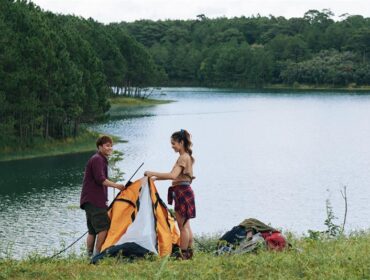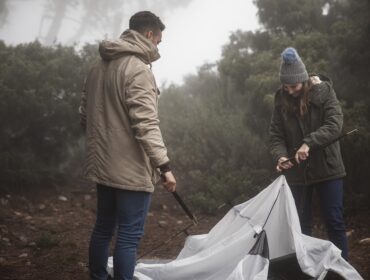Nothing beats the freedom of a road trip – especially one that leads you straight into nature. Whether you’re winding through national parks, exploring coastlines, or camping beneath the stars, a well-planned road trip lets you combine the best of car travel and outdoor living. But to fully enjoy the experience, preparation is key.
In this blog, we’ll walk you through the ultimate road trip camping checklist for 2025, updated with modern essentials, gear trends, and smart packing strategies. Whether you’re car camping solo, heading out with family, or joining a convoy of friends, this comprehensive guide will help you stay organized, safe, and comfortable on the road.
Road Trip Camping Basics: Plan First, Pack Second
Before diving into gear, take care of the fundamentals:
Choose Your Route
Use apps like Roadtrippers, iOverlander, or Gaia GPS to plan your path. Decide whether you’ll be camping at established sites, dispersed areas, or a mix of both. Pre-book your stays when possible, especially at national parks.
Know the Rules
Research campfire restrictions, permits, and vehicle requirements. BLM land, National Forests, and state parks all have different guidelines.
Get a Maintenance Check
Before any extended drive, inspect tires, fluids, brakes, and lights. Carry a spare tire, jumper cables, and know how to use them.
The Ultimate Road Trip Camping Checklist
1. Shelter & Sleep Setup
Your sleeping situation can make or break your trip. You might sleep in your tent, car, rooftop camper, or even a hammock—but make sure it’s weather-ready and comfortable.
Must-Haves:
-
Tent (freestanding, waterproof, with rainfly)
-
Sleeping bag (rated for expected temps)
-
Sleeping pad, air mattress, or cot
-
Camping pillow or compressible pillow
-
Ground tarp or footprint
-
Extra stakes and guylines
-
Headlamp or lantern
Pro Tip: If you’re vehicle camping, consider blackout window covers and a quality mattress topper to turn your backseat into a cozy nest.
2. Cooking & Food Storage
Camp cooking doesn’t have to be complicated. Bring the right tools to enjoy fresh meals without relying on gas station snacks.
Must-Haves:
-
Portable stove or grill (propane or butane)
-
Fuel canisters
-
Cookware (non-stick skillet, pot, kettle)
-
Reusable utensils, plates, bowls, mugs
-
Cutting board and knife
-
Sponge, dish soap, and drying cloth
-
Cooler or electric fridge
-
Food containers and storage bags
-
Non-perishable snacks and backup meals
-
Collapsible water jug (2-5 gallons)
Nice-to-Haves:
-
Percolator or pour-over coffee maker
-
Spices and condiments kit
-
Biodegradable trash bags
-
Camp table and folding chairs
3. Clothing Essentials
Layering is key when you’re camping in multiple climates. Plan for wind, rain, sun, and nighttime chills.
Must-Haves:
-
Waterproof jacket or shell
-
Moisture-wicking base layers
-
Quick-dry shirts and pants
-
Wool or synthetic socks
-
Comfortable walking shoes or hikers
-
Hat for sun or warmth
-
Gloves and thermal layers (if cold)
-
Swimsuit (hot springs, lakes, or showers)
-
Camp pajamas or sweatpants
-
Laundry bag
Pro Tip: Pack at least one full backup outfit in a dry bag in case of rain or mud.
4. Personal Hygiene Kit
Staying clean on the road is possible with a few compact essentials.
Must-Haves:
-
Toothbrush, toothpaste, floss
-
Biodegradable soap or wipes
-
Hand sanitizer
-
Toilet paper and trowel (for backcountry use)
-
Quick-dry towel
-
Medications
-
Razor, deodorant, and feminine hygiene products
-
Sunscreen and lip balm (SPF 30+)
-
Bug spray or wipes
Optional:
-
Portable camp shower
-
Shower sandals
-
Mirror and comb
5. Navigation & Communication
Cell signal can be spotty in remote areas, so plan for offline access.
Must-Haves:
-
Printed maps or atlas
-
Phone with GPS apps (download offline maps)
-
Power bank or solar charger
-
Compass
-
Itinerary left with a friend or family member
Nice-to-Haves:
-
Satellite communicator or emergency beacon (like Garmin inReach)
-
CB radio or walkie-talkies (for convoying)
6. Safety & Emergency Gear
Accidents happen. Be ready for minor mishaps and unexpected issues.
Must-Haves:
-
First-aid kit (with tweezers, gauze, antiseptic, etc.)
-
Multi-tool or Swiss Army knife
-
Flashlights and extra batteries
-
Fire extinguisher
-
Car emergency kit (including tire repair, jumper cables)
-
Duct tape and zip ties
-
Emergency whistle and flare
-
Reflective vests and glow sticks
Pro Tip: Pack gear in color-coded bins so you can grab what you need quickly.
7. Camp Comfort & Extras
Add these for a more enjoyable and relaxing road trip experience.
Must-Haves:
-
Camping chairs or hammock
-
Lanterns or string lights
-
Books, games, or cards
-
Bluetooth speaker (keep volume respectful)
-
Camera or GoPro
-
Collapsible wine glasses or drinkware
-
Blanket or picnic mat
Fun Ideas:
-
Frisbee or football
-
Binoculars for wildlife watching
-
Camp journal
8. Optional Tech & Upgrades for 2025
Thanks to a rise in overlanding and vehicle-based camping, a few modern upgrades are becoming more popular in 2025:
-
Portable Power Station (like the Anker SOLIX or Jackery Explorer)
-
Rooftop Tent or SUV Tent Extensions
-
GPS Tracker with group location sharing
-
Electric coffee maker or USB blender
-
Wi-Fi booster or signal repeater
-
Tablet with offline movies or guides
Weather Prep: Be Ready for Anything
The beauty of road trips is that you can chase good weather – or be caught by surprise. Here’s how to prep:
-
Bring a weather radio or check conditions with apps like Windy and MyRadar
-
Pack layers, even in summer – you might experience different climates within hours
-
Use a tarp or awning to create a dry cooking/eating space
-
Carry sandbags or extra stakes in case of wind or storms
Leave No Trace (LNT) While Camping
As road trips bring more people into wild areas, respecting nature is more important than ever.
Follow the 7 LNT Principles:
-
Plan ahead and prepare
-
Travel and camp on durable surfaces
-
Dispose of waste properly
-
Leave what you find
-
Minimize campfire impact
-
Respect wildlife
-
Be considerate of others
Use designated trash receptacles or pack it out, especially in dispersed or remote sites.
Final Packing Tips
-
Create a master checklist before you leave
-
Pack heaviest items low and secure in your vehicle
-
Use clear plastic bins for easy access
-
Pack for spontaneity – bring an extra day’s worth of food, water, and fuel
-
Double-check reservations and permits
Hit the Road with Confidence
A road trip camping adventure in 2025 can be the perfect reset – from digital detoxes to jaw-dropping natural wonders. But the real key to success? Planning.
Whether you’re venturing out for a weekend or a month-long cross-country loop, this checklist ensures you’re prepared for comfort, fun, and safety. Start with the essentials and build from there. And remember: It’s not just about the destination – it’s about the journey, the campfires, the scenic pullouts, and the freedom to explore.
So fuel up, pack smart, and get ready to make memories that last.
FAQs: The Ultimate Road Trip Camping Checklist for 2025
What’s the difference between car camping and road trip camping?
Car camping usually means driving to a single campsite and setting up camp near your vehicle. Road trip camping involves traveling to multiple destinations, often combining scenic drives, dispersed camping, and overnights at various sites. It requires more organization and gear versatility.
How do I choose the best sleeping setup for road trip camping?
Your sleep setup depends on your vehicle and personal preferences. You can sleep in a tent, your car, a rooftop tent, or even a camper van. Just make sure you have a comfortable sleeping bag, pad or mattress, and protection from the elements (rainfly, window shades, etc.).
What kind of food should I bring on a road trip camping adventure?
Opt for a mix of non-perishable snacks (nuts, jerky, granola bars), easy-to-cook meals (pasta, rice, canned goods), and fresh items stored in a cooler or fridge. Don’t forget essentials like cooking oil, spices, and utensils. Always bring more water than you think you’ll need.
How do I stay clean while camping on the road?
Bring biodegradable soap, wet wipes, hand sanitizer, a quick-dry towel, and a compact hygiene kit. You can also use portable showers or visit campgrounds with facilities. A collapsible water jug can be useful for washing hands and dishes.
Do I need to make campground reservations in advance?
Yes – especially in popular parks and during peak seasons. Use websites like Recreation.gov, Hipcamp, or state park portals to book early. For spontaneous travelers, apps like iOverlander can help you find free or first-come-first-served sites.





